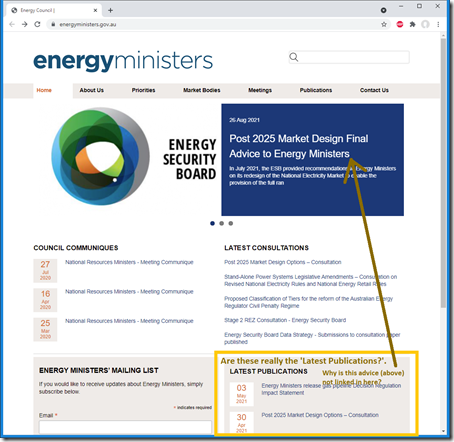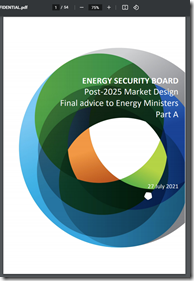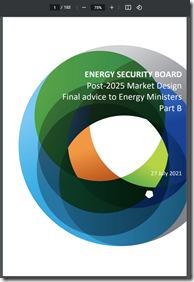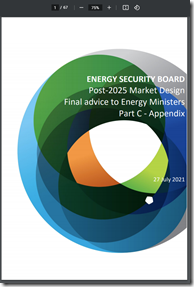For comedians searching for good material … look no further than the Australian efforts for energy sector reform, to facilitate this energy transition whilst keeping the lights on.
—-
For me, the Australian effort (driven by the political overlay from our ‘Emperors with No Clothes’) has begun looking increasingly like what Monty Python would have come up with if they had been handed the movie outline for Inception:
(a) worlds within worlds, with each one increasingly bizarre and far-fetched.
(b) almost like it had been set up to fail … despite the best earnest efforts of a number of well-meaning people working within the process.
1) Let’s reflect for a moment on the fact that we’ve had advice from the ESB (labelled ‘Top Secret’ – dunno why?!) that was provided to the Energy Ministers on Wednesday 28th July 2021 locked in the ‘Top Secret’ cabinet for the past >4 weeks … that same ‘Top Secret’ cabinet that has as many holes as the Titanic had leaks – the result of which we’ve had enough reams of commentary from a variety of parties that made me start to think I was really on the outer for not having seen a copy!
2) Knowing that we’ve had a copy released early this morning (thanks to the eager beavers in the media who published a number of articles alerting us to this fact), Google helped me find the page at https://www.energyministers.gov.au/ for the first time … which seems like an appropriately named place to go:
(a) the URL is relatively straightforward, and suggests it will be where to go to get some advice the Energy Ministers received and deigned that the plebs (like us) should be able to belatedly read a little over 4 weeks later
(b) … but not so fast, if you expect to find them under ‘Latest Publications’ (image as at ~20:30 on Thursday 26th August 2021)!?
3) Now, two clicks through (i.e. on the blue box at the top, but not in (supposedly) Latest Publications) brings me to this page which links to three pieces of the advice from the ESB – which are linked here, to hopefully avoid our readers also having to traverse this particular Rabbit Hole:
|
Part A |
Part B |
Part C |
|
Thanks to someone on social media early this morning (as it was not emailed to me officially until ~11:40 today … i.e. nearly 12 hours after it made the headlines in many newspapers) we can download the 54-page Part A now: Given that it’s been officially kept under wraps we will review with keen interest.
|
It was not until I was able to reach the official site that I was able to find the 152-page Part B, which apparently contains a bit more ‘meat on on the bones’ compared to the higher level skeleton in Part A: Likewise, we’ll review this will keen interest! |
Likewise for this 67-page ‘Part C’ which is labelled ‘Appendix’ I’ve not reviewed at all, but will read with keen interests (at least in part because it might give us other ideas for what to explore in the upcoming release of GenInsights21). |
4) So here I was thinking that this was all that the ESB had provided to the Energy Ministers … but we need to click through on the link in ‘Please visit the microsite for more information.’ in order to understand that there was more information published … which appears to be sometime in between this media release (and not much more) on 28th July 2021 and today. There is:
(a) ESB Presentation ‘Delivering Adequate Power Supplies Right Now and Into the Future’ on ?? July 2021 … made available publicly not sure when?!
(b) ESB presentation ‘Opening the grid to cheaper renewables’ from ?? July 2021 … made available publicly not sure when?!
(c) ESB Presentation ‘Clean and Smart Power in the New Energy System’ from ?? July 2021 … made available publicly not sure when?!
(d) Cornwall insight ‘Essential System Service Modelling’ report on 23rd July 2021 … made available publicly not sure when?!
(e) NERA’s ‘Valuing Load Flexibility and Resource Adequacy Mechanisms in the NEM’ report on 26th July 2021 … made available publicly not sure when?!
(f) FTI Consulting’s ‘Forecast Congestion in the NEM’ report on 5th August 2021 (clearly after ESB had provided their ‘Final’ advice to the Energy Ministers?!) – which seems accompanied by this 2-page ‘At a Glance’ explainer from the ESB … both made available publicly not sure when?!
(g) Maybe there is more … I don’t know and, frankly, don’t have a whole lot of confidence that I have found everything I would need to consider in order to understand the totality of what the ESB had proposed to the Energy Ministers!
5) Whilst the (new – or at least new to me?!) https://www.energyministers.gov.au/ website only has a fraction of the information together – at least it’s a lot easier to remember than the microsite URL ( https://esb-post2025-market-design.aemc.gov.au/ – yep, that’s a mouthful) that is practically impossible to remember or find again without the benefit of a remembering that there’s a link from the AEMC website, or a search in Google.
How much easier might it have been if www.EnergySecurityBoard.gov.au had been registered and used as the prime address for anything the ESB was involved in from the time it was set up? That URL (not sure if the domain is registered?) is still not even redirected?!
6) ‘Final’ is certainly not Final! Who was that ageing 80’s rock-star who cranked the handle repeatedly on the ‘Last Time Ever – Trust me this time!’ type of tours?
(a) With the ESB’s final advice seeming to be full of ‘needs detailed design’ type of acknowledgement, mixed with a dose of ‘might be this, might be that’ type of prescription, it certainly seems likely that we’ve not seen the end of these design deliberations!
(b) Maybe it won’t be the ESB that does this … or maybe it will be the same stakeholders, rebadged in some way … but the work still needs to be done (as the devil, being in the detail, is pretty transparent at present).
7) When we started down this pathway (i.e. remembering the Finkel Review was published 1st June 2017 … > 4 years ago now) I was hoping that this process would end up with a real design for NEM 2.0 that would provide us with a framework to get us to 2040 and beyond. Unfortunately the way it has unfolded:
(a) It seems what we have been provided is a NEM 1.5 conceptual design under the ‘post 2025’ label… and then only now at a high level.
(b) This may not be operational until well past 2025 … remembering that it’s mid 2021, the ESB is talking about 18+ months of detailed design (hopefully not including more random month-long ‘top secret periods’ that appears to be for no good reason) – and then there will be an implementation period that might rival Five Minute Settlement in its complexity, in terms of how it touches much of the way the NEM works.
(c) Which might mean some initiatives arrive way after when they are actually needed.
(d) And even then, there will still be design concepts (like making Demand Response work with Negative Prices via some form of two-sided market) that seem a long way away from detailed consideration … meaning that (as an investor) I’ll be thinking about investing in NEM 1.5 knowing that the rules might change again sometime afterwards when the evolution continues towards NEM 2.0
Seems certain to change investment decisions made by many based on a ‘can I make a quick return’ or ‘I need a higher risk-weighted return’ type of decision matrix.
—-
So with all of the above in mind (and many more layers) let’s celebrate the small wins … in that we* are now all able consider the advice that the ESB offered that was ostensibly in the interests of all of us involved in this energy sector transition!
* i.e. “we” being all of us – not just those who were in the immediate vicinity of the ‘Cone of Silence’ when it was lowered in an attempt at secrecy over the past 4 weeks)
Another win I saw in a very quick scan today on a small screen was that Part A of the ESB Final Advice (p13) provides this timeline and some discussion to help illustrate how we got to where we are currently at:
Not sure what the colours in the dots are supposed to mean, but some of these milestones have previously been marked in prior articles on WattClarity:
|
Date |
How we covered the milestone on WattClarity (if we did) |
|
1st June 2017. Finkel Review |
Noting again that the Finkel Review was released 1st June 2017. |
|
Sept 2019. Post 2025 Issues Paper |
I don’t think we wrote about this at the time? |
|
March 2020 Two Papers |
On 25th April 2020 I’d noted about the two papers released by the COAG Energy Council – about: 1) Two-Sided Markets. 2) System Services and Ahead Markets. |
|
Sept 2020 Post 2025 Consultation Paper |
On 7th Sept 2020 we noted that the ESB had released the Consultation Paper. |
|
Dec 2020 Post 2025 Directions Paper |
I don’t think we wrote about this at the time? |
|
March 2021 Post 2025 Market Design Options Paper |
On 30th April 2021 we noted the Options Paper had been released – and included some scepticism about the extent to which it was a ‘NEM 2.0’ design to get us beyond 2040. |
|
July 2021 Post 2025 Market Design Recommendations |
On 29th June 2021 we noted the short media release was published the day previous … on the day that the Energy Ministers met. |
|
Thursday 26th August 2021 Belated Publication, 4 weeks later |
After leaking like a sieve in Angus Taylor’s filing cabinet, the ESB’s ‘Final’ Design Recommendations have finally been publicly released today … hence this article. |
|
When? What’s the next milestone? |
What’s in the next instalment of this Keystone Cops style of tragi-comedy? |
No doubt there will be more later…







One possible reason for the delay in coming up with something clear and meaningful is that the task they have set for themselves, or the task that they are expected to perform, is impossible.
They are supposed to come up with a plan to proceed towards net zero with all possible speed by building more RE capacity plus [think of a number] GW of dispatchable firming capacity from batteries, gas and pumped hydro. Can we get enough gas? believe pumped hydro when you see it and forget about batteries for getting through windless nights (do the arithmetic).
We are supposed to end up with less emissions, cheaper power and a more reliable grid. Tell that to the Germans.
And don’t mention the environmental impact, the impending avalanche of toxic waste and the extra reliable power required for the great leap forward into electric vehicles.
But don’t laugh, this is serious!
Coal has to go, one way or another, although the Government it also has to stay, one way or another, as long as necessary. How long as that?
With the right Energy Policy in place, I don’t care whether Generators elect to use; wind, water wheel, tidal power, solar-PV, Bio-fuels, fossil fuels, batteries, nuclear, or even pedal power, if that’s what turns them on.
Provided they don’t expect to receive a subsidy from taxpayers to underwrite their fantasy.
In brief, I’m of the view that all Australia, and or any other country, needs is a sensible Energy Policy in keeping with market forces that;
• Is technology agnostic;
• Has clearly defined QOS standards eg 24/7 power available, reliable & affordable;
• Facilitates / encourages strong competition between generators to deliver their best price per GWh for guaranteed power output eg 100% (force majeure permitting);
• Provides no subsidies & repeals past legislation that provides for same (eg in Australia the RET, LRET, Safeguard Mechanism); and
• Importantly, imposes substantial financial penalties for any failure to meet contracted QOS obligations for an essential service.
Easy.